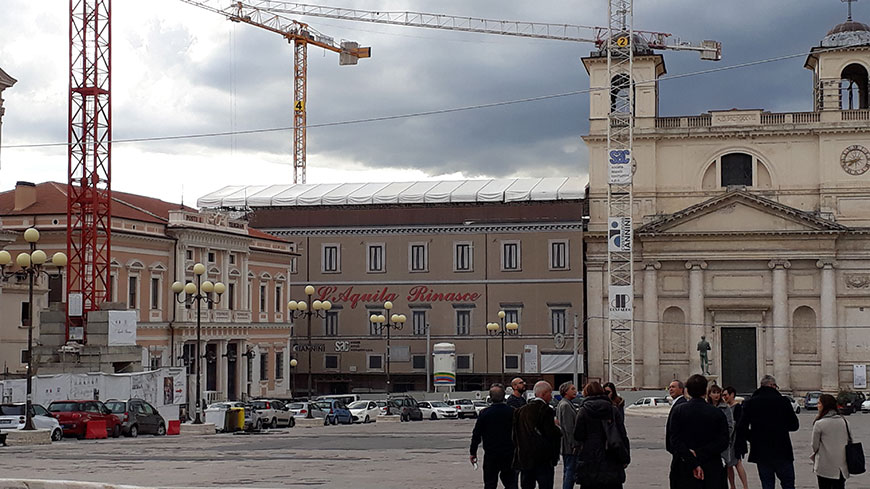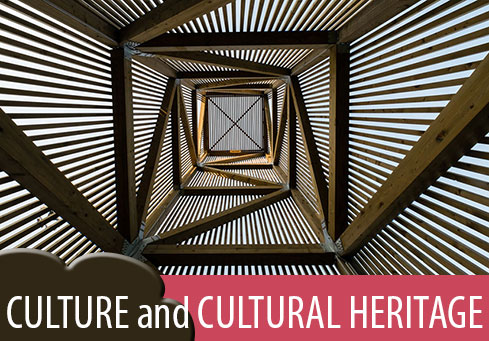The Faro Convention Action Plan, in consultation with the Council of Europe’s EUR-OPA Major Hazards Agreement, carried out a research study in Fontecchio, Italy in October 2017.
Fontecchio is a small medieval village, in the province of L’Aquila, located in a regional park (Monte Sirente), but also in a zone with regular seismic activity (earthquakes[1]).
A discussion centring on community preparedness and post-disaster revitalisation was held amongst academics and civil society organisations, with a focus on the active role of communities and heritage in the revitalisation process. Participants have kindly offered their opinions in short articles here, to generate further discussion and to encourage action in the heritage field.
The articles bring together a selection of examples, case studies and viewpoints on specific situations across a range of European countries. Heritage and community revitalisation is approached with specific attention to heritage and social change, heritage as an ecosystem of development, and making heritage accessible. From these different angles, we see what a people-centred approach means in practice; what we need to know before we act; and what challenges exist that we may or may not be prepared for.
Article 1
In this article, Matthias Ripp (PhD candidate, Brandenburg University of Technology Cottbus-Senftenberg, Germany) explores the development in our understanding of heritage (starting from an object-based approach and evolving towards today’s integrated approach) which leads us to the importance of putting people at the centre of heritage-led actions.
Article 2
In this article, Mr. Luís Raposo (archaeologist, President of ICOM-Europe, Portugal) investigates the potential of heritage to revitalise areas suffering from depopulation by applying an innovative and integrated, people-centred approach to the role of the museum in the community, assisted by different examples of existing practice from Portugal.
- The Challenges for Museums in Abandoned Lands - Luís Raposo
Article 3
In this article, Valeria Pica (PhD candidate, Malta University and ICOM-CECA, Italy) defines the museum as the “ideological and cultural symbol of a community” with the potential for encouraging community-building and social cohesion through the application of an integrated, multi-level approach.
- Heritage as a Tool for Community-Building - Valeria Pica
Article 4
In this article, Andrea Sieber (researcher, Alps-Adria-University Klagenfurt) explores the way to use intangible cultural heritage to foster community and build social bridges using the example of the Austrian Bread Time project, which brings young and old people together over Lesachtal bread. The transmission of informal local knowledge through a sharing experience enhances social inclusion and shows the value of applying a local, people-centred approach to cultural heritage.
- Local knowledge as research tool to save Cultural Heritage - Andrea Sieber
Article 5
In this article, Margherita Sani (NEMO Network of European Museum Organisations, Istituto Beni Culturali Regione Emilia Romagna) gives a structured breakdown of the components of accessibility to museums. These components form the essential basis of the Social Justice Model of museums, in which a people-centred approach is recognised as being the responsibility of all staff and the museum is understood as being embedded in society, with a duty to help society meet its standards of justice.
- Making heritage accessible: museums, communities and participation - Margherita Sani
Article 6
In this article, Marie Gaillard (freelance consultant and researcher, France) examines the role of the individual in the context of post-disaster heritage revitalisation, and in particular the case of Fontecchio, through the application of a three-part model looking at identity, community and communication. In putting these concepts into action, Gaillard calls for a “return to the human”, valuing each person’s dignity and expertise, as a part of a dynamic, people-centred approach.
- People – Places – Stories: a workable threepart model for post-disaster heritage revitalisation? - Marie Gaillard
Article 7
In this article, Panas Karampampas (post-doctoral researcher, EHESS, France) explores the parallels in creating a sense of belonging and promoting integration in the cases of the Greek Jewish communities and new refugees in Greece through the means of intangible cultural heritage.
Article 8
Dans cet article, Manon Collin (doctorante, université d’Avignon, France) examine le rôle social du musée dans le cadre de l’accueil de différents publics, notamment les personnes issues de l’immigration. Collin soutient que les dispositifs de médiation sont nécessaires pour faciliter la compréhension de la part de ces publics et qu’il est important d'étudier les divers perceptions et rapports au patrimoine du pays d'accueil, en adoptant une nouvelle réflexion sur l’identité culturelle de l’Europe et la reconnaissance des individus en tant que « communauté patrimoniale ».
- L’accueil des migrants dans les structures muséales : quels enjeux sociétaux en Europe ? - Manon Collin [fr]
Article 9
In this article, Ángel Portolés-Górriz (PhD candidate, University Extension Programme Patrimoni project coordinator, Jaume I University, Spain) introduces the Jaume I University Patrimoni project, a collective process that aims to revitalise cultural heritage and citizen activity in rural areas. It serves to build cultural heritage projects in a people-centred way, with the voluntary involvement of local group members, based on participation and the exchange and communication of cultural heritage.
- An example of a heritage communities’ network: the Jaume I University Patrimoni project (Castellón) - Ángel Portolés-Górriz
[1] 6 April 2009 - L’Aquila and its surrounding villages were devastated by an earthquake: 309 people died, more than 10 000 buildings were damaged, 66 000 residents were made homeless. In Fontecchio, 40% of the buildings were damaged and needed urgent restoration.




